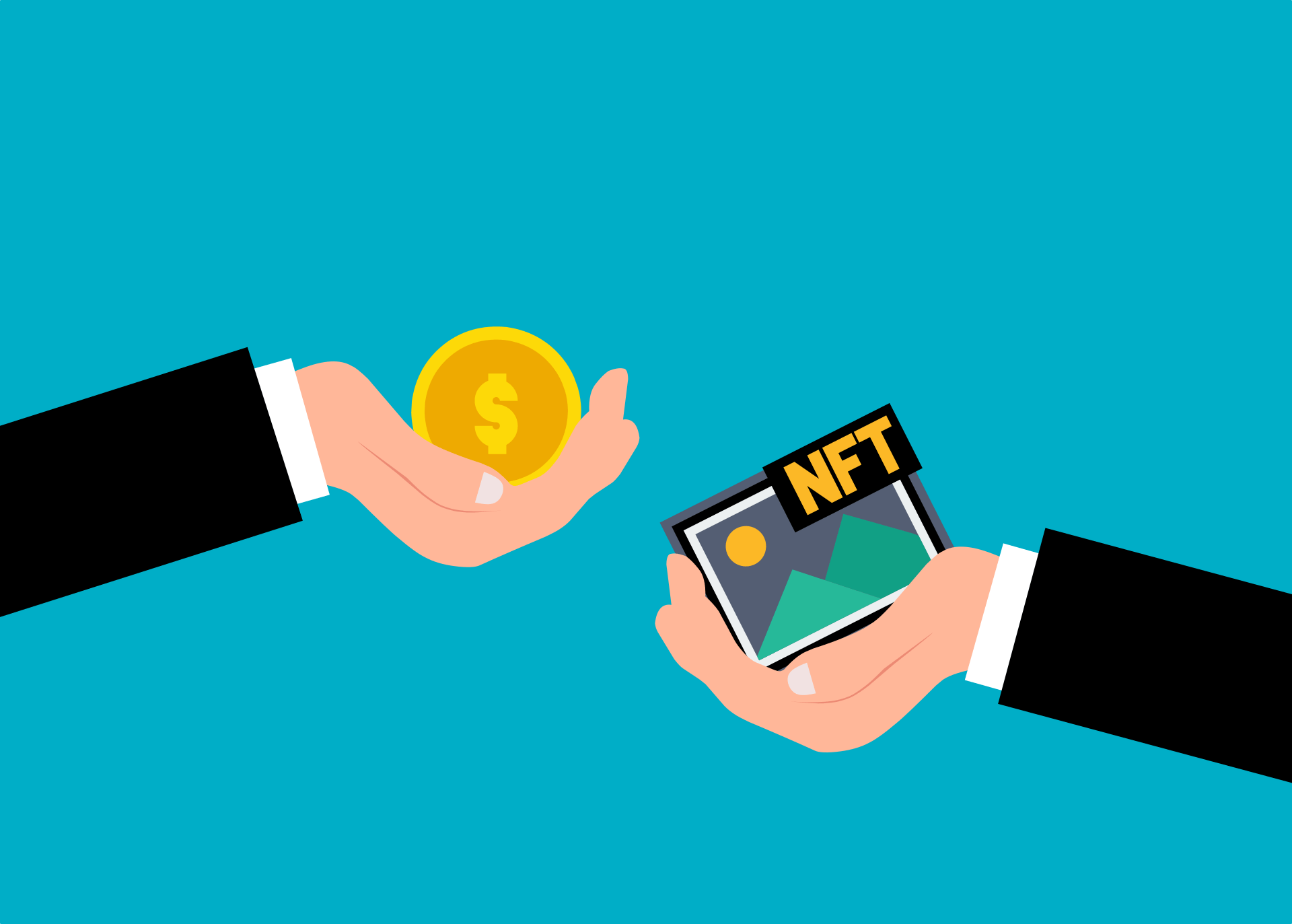What are NFTs and How do They Work?
NFTs, or Non-Fungible Tokens, work by using blockchain technology and smart contracts to verify and track ownership of unique digital assets.
Here’s a general overview of how NFTs work:
- A creator creates a unique digital asset, such as a piece of digital art or a collectible item in a video game.
- The creator mints the asset as an NFT, which involves uploading it to a blockchain and creating a smart contract that defines the asset’s ownership and characteristics.
- The NFT is then listed for sale on a marketplace or platform that supports NFTs.
- A buyer finds the NFT and decides to purchase it. The buyer sends the required payment, usually in the form of a cryptocurrency like Ether, to the smart contract.
- The smart contract verifies the payment and transfers ownership of the NFT to the buyer. The NFT is now stored in the buyer’s digital wallet.
- The NFT can now be bought and sold on the open market, with the smart contract and blockchain verifying ownership at each transaction.
This process allows for the creation and transfer of unique digital assets in a way that is secure, verifiable, and immutable. It also allows for the creation of a market for these assets, allowing creators to monetize their work and collectors to own and trade rare and valuable digital items.

I. Introduction
Welcome to the exciting world of NFTs, or Non-Fungible Tokens! You may have heard about NFTs in the news recently, or perhaps you’ve stumbled upon them in the digital art or collectibles world. But what exactly are NFTs and how do they differ from other digital assets?
First, let’s start with the definition of NFTs. In the simplest terms, NFTs are unique digital assets that are verified on a blockchain. This means that they are one-of-a-kind and cannot be replaced or exchanged for something else of equal value. This is in contrast to other digital assets, such as cryptocurrencies like Bitcoin or Ethereum, which are interchangeable and can be easily exchanged for goods or services.
NFTs are often used to represent ownership of a digital asset, such as a piece of digital art or a collectible item in a video game. They can also be used for other purposes, such as representing ownership of physical assets or access to events or experiences.
One of the key benefits of NFTs is that they offer a way to establish ownership and provenance of digital assets in a way that was not previously possible. This is especially important in the digital art world, where it can be difficult to establish ownership and prevent unauthorized copying. By using NFTs, artists and collectors can have a verifiable and immutable record of ownership.
So there you have it – a brief introduction to NFTs and how they differ from other digital assets. Stay tuned for more on the exciting world of NFTs!
II. What are NFTs used for?
As we’ve learned, NFTs, or Non-Fungible Tokens, are unique digital assets that are verified on a blockchain. But what are they used for exactly, and what is their potential in the future?
One of the most common uses for NFTs today is in the world of digital art and collectibles. With NFTs, artists can sell their digital creations as one-of-a-kind items, with the added security and verifiability of the blockchain. Collectors can then purchase and own these items as they would any other physical artwork or collectible. Some examples of digital art that has been sold as NFTs include pieces by world-renowned artists like Beeple and Trevor Jones.
NFTs are also being used in the gaming industry, where they can represent in-game items that are unique or rare. For example, a player might purchase an NFT to represent a rare weapon or piece of armor in a role-playing game. This allows players to own and trade these items in a way that is verifiable and secure.
But the potential of NFTs goes far beyond just digital art and gaming. Some experts believe that NFTs could be used to represent ownership of physical assets, such as real estate or fine art. They could also be used to represent access to events or experiences, such as concert tickets or VIP access to a sporting event.
The possibilities for NFTs are truly endless, and it’s clear that they have the potential to revolutionize the way we think about digital ownership and value. As the market for NFTs continues to grow and evolve, it will be exciting to see what new and innovative uses for them emerge.
III. How do NFTs work?
As we’ve learned, NFTs, or Non-Fungible Tokens, are unique digital assets that are verified on a blockchain. But what are they used for exactly, and what is their potential in the future?
One of the most common uses for NFTs today is in the world of digital art and collectibles. With NFTs, artists can sell their digital creations as one-of-a-kind items, with the added security and verifiability of the blockchain. Collectors can then purchase and own these items as they would any other physical artwork or collectible. Some examples of digital art that has been sold as NFTs include pieces by world-renowned artists like Beeple and Trevor Jones.
NFTs are also being used in the gaming industry, where they can represent in-game items that are unique or rare. For example, a player might purchase an NFT to represent a rare weapon or piece of armor in a role-playing game. This allows players to own and trade these items in a way that is verifiable and secure.
But the potential of NFTs goes far beyond just digital art and gaming. Some experts believe that NFTs could be used to represent ownership of physical assets, such as real estate or fine art. They could also be used to represent access to events or experiences, such as concert tickets or VIP access to a sporting event.
The possibilities for NFTs are truly endless, and it’s clear that they have the potential to revolutionize the way we think about digital ownership and value. As the market for NFTs continues to grow and evolve, it will be exciting to see what new and innovative uses for them emerge.
IV. How to create NFTs?
So, you’re interested in creating your own NFTs, or Non-Fungible Tokens? Great! NFTs are a fantastic way for creators to monetize their digital creations and for collectors to own and trade unique and rare items. But how exactly do you go about creating and listing your own NFTs?
First, let’s talk about the tools and platforms available for creating NFTs. There are a variety of options out there, ranging from simple drag-and-drop interfaces to more advanced tools for developers. Some popular platforms for creating NFTs include OpenSea, Rarible, and SuperRare. It’s important to choose a platform that fits your needs and comfort level, so be sure to do your research and try out a few options before making a decision.
Once you’ve chosen a platform, the next step is to create and list your NFT. The specific steps involved will vary depending on the platform you choose, but here’s a general overview of the process:
- Create your digital asset. This could be a piece of digital art, a collectible item, or anything else that you want to represent as an NFT.
- Mint your asset as an NFT. This involves uploading it to the blockchain and creating a smart contract that defines the asset’s ownership and characteristics.
- Set a price and any other relevant details for your NFT. This could include a starting price, a reserve price, or a buy-it-now price.
- List your NFT for sale on the platform. This will make it visible to potential buyers and allow them to purchase it.
- Wait for a buyer to purchase your NFT. When a buyer makes a purchase, the smart contract will verify the payment and transfer ownership of the NFT to the buyer.
Creating and listing your own NFTs can be a rewarding and exciting experience, and it’s a great way to get involved in the growing world of NFTs. With the right tools and platform, anyone can start creating and selling their own NFTs.
V. Where to create NFTs?
So, you’ve created your own NFTs and you’re ready to start selling them to the world. But where should you go to list your NFTs and find buyers? There are a variety of NFT marketplaces and platforms available, each with its own unique features and audience. In this section, we’ll explore some popular options and offer tips for choosing the right platform for your NFTs.
One of the most well-known NFT marketplaces is OpenSea, which offers a wide range of NFTs across a variety of categories, including art, collectibles, and gaming items. OpenSea is a good option for creators and collectors looking for a wide audience and a variety of buying and selling options.
Another popular platform is Rarible, which focuses specifically on NFTs for digital art and collectibles. Rarible offers a variety of tools and features for creators, including the ability to set up auctions and customize the look and feel of your NFT listings.
SuperRare is another platform that focuses on digital art NFTs, offering a curated selection of high-quality art from top creators. SuperRare is a good option for creators looking to showcase their work to a discerning audience of collectors.
These are just a few of the many NFT marketplaces and platforms available, and there are many others to choose from. When selecting a platform, it’s important to consider factors such as fees, audience, and the types of NFTs that are most likely to sell well on the platform. It may also be helpful to try out a few different platforms and see which one works best for you.
List Of Sites To Create NFTs:
- OpenSea. The broadest and most established NFT marketplace. …
- Magic Eden. The best Solana NFT marketplace. …
- Nifty Gateway. The NFT marketplace with big drops. …
- Rarible. The NFT marketplace for rare media and sports collections. …
- Coinbase NFT. The well-connected NFT marketplace. …
- etc. …
In summary, there are many great options for creating and selling NFTs, and the right platform for you will depend on your goals and preferences. With a little research and experimentation, you can find the perfect platform for your NFTs and start building your own successful NFT business.
Conclusion:
In conclusion, NFTs, or Non-Fungible Tokens, are a revolutionary new type of digital asset that offers a way to establish ownership and provenance of digital items in a secure and verifiable way. NFTs are being used for a wide range of purposes, including digital art, collectibles, and gaming items, and their potential extends far beyond these uses.
The impact of NFTs on the future of digital ownership is difficult to predict, but it’s clear that they have the potential to change the way we think about and value digital assets. For creators, NFTs offer a new way to monetize their work and reach a global audience. For collectors, NFTs offer the opportunity to own and trade unique and rare items in a way that was not previously possible.
Understanding NFTs and how they work is important for anyone interested in the world of digital art, collectibles, and beyond. As the market for NFTs continues to grow and evolve, it’s important to stay up-to-date and understand the potential impact of these innovative assets. So, it is always important to keep an eye on the developments in the world of NFTs and stay informed about the latest trends and opportunities in this exciting field.

